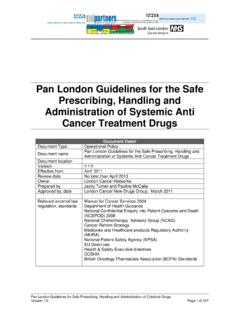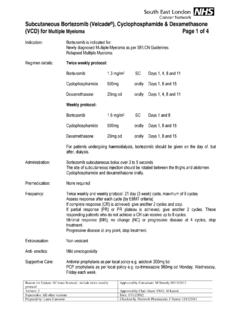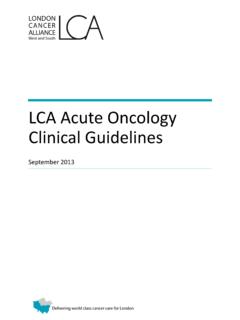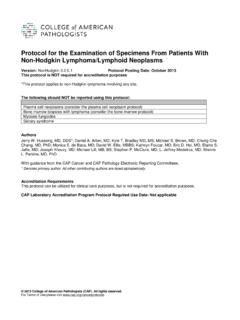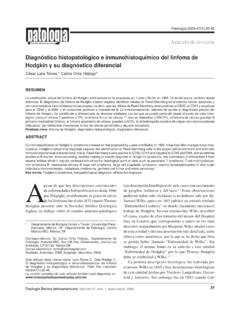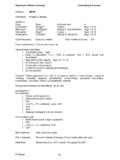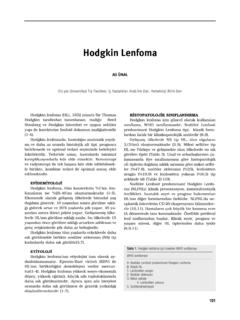Transcription of LCA Haemato-Oncology Clinical Guidelines
1 LCA Haemato-Oncology Clinical Guidelines Lymphoid Malignancies Part 1: hodgkin Lymphoma August 2015. LCA Haemato-Oncology Clinical Guidelines . Contents 1. Introduction .. 4. 2. Referral Pathways from Primary 4. 3. Investigation and Diagnosis .. 5. Initial assessment and investigation .. 5. Pathology .. 5. Staging and risk assessment .. 6. 4. Service Configuration across the 8. Children, teenagers and young 8. 5. Patient Information and Support .. 9. 6. Treatment Recommendations .. 10. Treatment of early stage favourable classical hodgkin lymphoma .. 10. Treatment of early unfavourable and advanced stage classical hodgkin lymphoma .. 10. Treatment of hodgkin lymphoma in special circumstances .. 11. The use of 18F-FDG PET in classical hodgkin 12. Management of relapsed classical hodgkin 14. 7. Management of Common Disease and Treatment-related Complications.
2 16. Superior vena cava 16. Cord 16. Febrile neutropenia .. 16. Nausea and vomiting .. 17. Tumour lysis syndrome and hyperuricaemia .. 17. Bleomycin lung toxicity .. 17. 8. Supportive Care .. 18. Transfusions .. 18. Thrombosis/haemostasis .. 18. Breathlessness .. 18. Weight loss .. 18. Pain .. 19. Complex symptom management .. 19. 2. CONTENTS. 9. End of Treatment Information .. 20. Treatment summary and care plan .. 20. 10. Follow-up Arrangements .. 21. 11. Rehabilitation and Survivorship .. 22. 12. Research and Clinical Trials .. 22. 13. End-of-life Care .. 23. 14. Nodular Lymphocyte Predominant hodgkin Lymphoma (NLPHL) .. 24. Diagnostic criteria .. 24. Essential investigations .. 24. Primary treatment .. 24. Treatment of relapsed NLPHL .. 25. References .. 26. Annex 1: Multidisciplinary Teams (MDTs) and Constituent Hospital Trusts .. 28. Annex 2: SIHMDS or Current Diagnostic Services and Contacts.
3 29. Annex 3: Guideline for the Management of Tumour Lysis Syndrome (TLS) .. 30. Annex 4: Guidelines for Use of Rasburicase in Adult Haematology and oncology 32. Appendices .. 34. LCA Haemato-Oncology Clinical Guidelines . 1. Introduction hodgkin lymphoma (HL) accounts for approximately 15% of all lymphomas in the UK; around 1,700 people are diagnosed with HL each year and it is slightly more common in men than in The majority of these cases fall under the category of classical hodgkin lymphoma' while the remaining are nodular lymphocyte predominant hodgkin lymphoma (NLPHL). The latter is a separate disease entity from classical HL and more information on NLPHL can be found in section 14. Classical HL is the most common form of haematological cancer in teenagers and young adults, with peak incidence between 15 and 35 years. After young adults, the most frequently affected age group are the over-55s, although any age group can be affected.
4 It is extremely rare in young children. Overall, patients with classical HL have a good outcome and the majority are cured with first-line treatment. With current treatment, around 8 out of 10 patients survive this lymphoma. In particular, young adults, if diagnosed early, have an excellent prognosis and almost all survive. Most patients do very well and suffer minimal side effects in the long and short term. However, it is important that selected patients, for example those receiving radiotherapy to the mediastinum, continue to be followed up because of long- term risks associated with the treatment used for hodgkin lymphoma. 2. Referral Pathways from Primary Care Rapid referral for investigation of significant lymphadenopathy, especially in the presence of B-symptoms, should be made on the same day on a 2 week wait pathway (see Appendix 1: 2 Week Wait Referral Forms).
5 Triggers for referral may come from an enlarged lymph node from GPs or from specialist medical or surgical teams. Most patients will present with painless lymphadenopathy and diagnosis is made from lymph node biopsy. 4. INVESTIGATION AND DIAGNOSIS. 3. Investigation and Diagnosis An accurate diagnosis of HL requires an adequately sized surgical specimen or excisional lymph node biopsy and should be made according to the World Health Organization (WHO) classification. In classical HL, scattered binucleate or multinucleate hodgkin and Reed Sternberg (HRS) cells and mononuclear hodgkin cells are seen, associated with a reactive cellular infiltrate of lymphoid cells, eosinophils and other inflammatory cells. Immunohistochemistry is an important aid to diagnosis in HL. In classical HL, HRS cells are positive for CD30 in nearly all cases and CD15 in approximately 80%.
6 They are usually CD45 negative and are J chain negative. CD20 is variably expressed as is the EBV encoded latent membrane protein (LMP1). Classical HL includes nodular sclerosing (NS), mixed cellularity (MC), lymphocyte-rich (LR) and lymphocyte- depleted (LD) sub-types. Initial assessment and investigation These should include: full blood count (FBC) + differential, erythrocyte sedimentation rate (ESR). serum biochemistry: renal profile, liver profile, bone profile, uric acid, albumin, lactate dehydrogenase (LDH) and C-reactive protein (CRP). serum immunoglobulins and electrophoresis HIV, hepatitis B and C testing bone marrow aspirate and trephine is not mandatory if PET-CT is performed2. contrast enhanced CT scan of the neck, chest, abdomen and pelvis FDG-PET. MUGA/ECHO for left ventricular ejection fraction measurement prior to either induction chemotherapy or ablative therapy (optional).
7 Pulmonary function tests (optional) request TLCO and KCO. sperm cryopreservation or referral for egg/embryo harvesting if appropriate plus referral for reproductive counselling. Consideration of fertility preservation should be made for those of reproductive age (men below the age of 55 and women below the age of 40). Please see the LCA Guidance and recommendations for referral to fertility services for more information on referral criteria and contact details for services. Pathology Careful attention must be paid to the labelling of forms and samples before sending to the SIHMDS (see Annex 2). Samples are unlikely to be processed unless clearly and correctly labelled. 5. LCA Haemato-Oncology Clinical Guidelines . Staging and risk assessment Using the Modified Ann Arbor staging system, HL is divided into early stage I II or advanced stage III IV.
8 Disease. Table 1. Ann Arbor staging system Stage Prognostic groups Stage I Involvement of a single lymph node region (I) or of a single extralymphatic organ or site (IE). Stage II Involvement of two or more lymph node regions (number to be stated) on the same side of the diaphragm (II) or localised involvement of extralymphatic organ or site and of one or more lymph node regions on the same side of the diaphragm (IIE). Stage III Involvement of lymph node regions on both sides of the diaphragm (III) which may also be accompanied by localised involvement of extralymphatic organ or site (IIIE) or by involvement of the spleen (IIIS) or both (IIISE). Stage IV Diffuse or disseminated involvement of one or more extralymphatic organs or tissues with or without associated lymph node enlargement. Organ should be identified by symbols A No symptoms B Fever, drenching night sweats, loss of more than 10% of body weight over 6 months X: Bulky disease: >1/3 mediastinum at the widest point; >10cm maximum diameter of nodal mass E: Involvement of single, contiguous or proximal, extra nodal site Classification of early stage HL into favourable and unfavourable categories can guide treatment decisions.
9 The German hodgkin Study Group (GHSG) and the European Organisation for the Research and Treatment of Cancer (EORTC) criteria for favourable and unfavourable disease are listed below. Table 2. Criteria for favourable and unfavourable disease EORTC GHSG. Favourable risk factors No large mediastinal adenopathy No large mediastinal adenopathy ESR <50 with no B-symptoms ESR <50 with no B-symptoms ESR <30 with B-symptoms ESR <30 with B-symptoms Age <50 No extranodal disease 1 3 lymph node sites 1 2 lymph node sites Unfavourable risk factors Large mediastinal adenopathy Large mediastinal adenopathy ESR >50 with no B-symptoms ESR >50 with no B-symptoms ESR >30 with B-symptoms ESR >30 with B-symptoms Age >50 Extranodal disease >4 lymph node sites >3 lymph node sites 6. INVESTIGATION AND DIAGNOSIS. In advanced stage HL, the International hodgkin 's Lymphoma Prognostic Score (IHDPS)3 should be calculated.
10 One point is assigned to each of the following seven prognostic factors: age >45 years male sex serum albumin concentration <40g/L. haemoglobin concentration <105g/L. Stage IV disease leucocytosis >15 x 109/L. lymphopenia < x 109/L or <8% of total white cell count. The rates of freedom from progression and overall survival according to the IHDPS or Hasenclever score'. are listed in the table below. Table 3. Freedom from progression and overall survival Prognostic Freedom from Overall survival score progression 0 84% 89%. 1 77% 90%. 2 67% 81%. 3 60% 78%. 4 51% 61%. >5 42% 56%. 7. LCA Haemato-Oncology Clinical Guidelines . 4. Service Configuration across the LCA. All patients with a diagnosis of hodgkin lymphoma should be seen in a British Committee for Standards in Haematology (BCSH) Level 2 centre or above within 2 weeks of referral. All patients must be discussed at diagnosis and relapse at the local network multidisciplinary team (MDT).




